Похожие презентации:
Air Pollution
1.
Air Pollution2.
What is air pollution?• Air pollution can be defined as the introduction of excessive quantities of substances,
gases, particles or biological molecules into the earth atmosphere.
• Air pollution may have negative impacts on humans in the form of allergies, diseases
or even death.
• It also has an adverse effect on animals and plants as well as on the whole ecological
system.
• Air pollution can be caused by both natural processes as well as by human behavior.
• According to the World Health Organization, 7 million people die from air pollution
each year.
• Thus, more people die each year from air pollution than from automobile accidents.
• In the following, we will examine the causes, effects as well as solutions to the air
pollution problem.
3.
Types of air pollution• Carbon dioxide
• Sulfur oxides
• Nitrogen oxides
• Carbon monoxide
• Volatile organic compounds (VOCs)
• Particulate matter
• Persistent free radicals
• Toxic metals
• Chlorofluorocarbons (CFCs)
• Ammonia
• Odors
• Radioactive material
4.
CausesDust
Animals
Radioactive decay
Wildfires
Vegetation
Volcanoes
Aircraft
Vehicles
Marine vessels
Waste deposition in landfills
Military sources
Fossil fuels
Mining
Agriculture
Industry
Private households
5.
Dust• Dust is composed of fine particles of solid matter.
• Dust is usually emitted through natural processes, usually in areas with little or no
vegetation.
6.
Animals• Animals produce methane in their digestion process.
• The emission of methane causes air pollution and also contribute to the global
warming issue.
• Although a big fraction of methane emission can be attributed to livestock from
domesticated farming practices, some of it also occurs from wild animals which also
emit methane in their daily habits.
7.
Radioactive decay• Radon is a radioactive element which naturally occurs inside our earth.
• From there, it can reach our groundwater and eventually also our air.
• Radon is produced in the process of radioactive decay and is considered as health
hazard.
8.
Wildfires• Wildfires often occur in areas with dry climate.
• They are often caused by human behavior like the incorrect disposal of cigarettes.
• There are some cases where wildfires are also started intentionally.
• For example, it is quite common for farmers in the Amazon Rainforest to burn down
large areas of forest in order to get more space for farming purposes.
• Wildfires can cause carbon monoxide and smoke.
• Large concentrations of carbon monoxide can lead to serious health problems and
even death of humans.
9.
Vegetation• Vegetation often emits large amounts of VOCs (volatile organic compounds),
especially on warmer days, which react with sulfur-oxides and nitrogen-oxides.
• VOCs can thus contribute to an increase in ozone levels.
10.
Volcanoes• Volcanic activity can cause ash particulates, chlorine and sulphur to enter the air.
• Especially in eruptions, large amounts of these substances are released into the air
which could even lead to a temporary flight stop in the affected area.
11.
Aircraft• Aircraft is a big source of air pollution.
• Airplanes emit large amounts of nitrogen-dioxide as well as carbon dioxide which in
turn contributes to global warming.
• Especially in the last decades, the number of flights increased significantly.
• More and more people are travelling to foreign countries.
• In addition, many people also travel by plane for business purposes.
• Thus, the amount of flights worldwide and therefore the level of air pollution from
aircraft increased substantially in the last decades.
12.
Vehicles• The use of vehicles of all sorts are another great cause for air pollution.
• Emissions from cars and other vehicles increase the levels of CO2 and other
greenhouse gases in the atmosphere and thus increase the global warming process.
• In our culture, it is quite common that almost everyone of us owns at least one car.
• Especially in suburbs or in rural areas, people rely on their cars to be able to
commute to work.
• However, even in areas where there is good public transport, people are usually
more likely to use their cars since this feels more convenient to them.
• Therefore, the emissions from cars and other vehicles increases with a steady rate,
which leads to an increase in air pollution and also contributes to the global warming
problem.
13.
Marine vessels• Marine vessels burn fossil fuels and thus emit several air pollution gases.
• These include nitrogen oxides, carbon dioxide and sulfur dioxide.
• These gases not only contribute to global warming but are also harmful for public
health.
14.
Waste deposition in landfills• The deposition of waste in landfills generates methane which even has a much
higher global warming potential than CO2 and therefore ranks as one of the most
harmful greenhouse gases.
• However, the total amount of methane emitted in our atmosphere compared to the
amount of CO2 is relatively low. Thus, CO2 is still the most harmful greenhouse gas in
absolute terms.
15.
Military sources• Nuclear weapons, rocketry and toxic gases can also contribute to air pollution.
• Many countries do weapon tests on a regular basis, either for training purposes or
also to threat other countries.
• By doing so, harmful substances are released into the air, which can cause air
pollution and other adverse effects to the environment.
16.
Fossil fuels• The combustion of fossil fuels is a main source of air pollution.
• Fossil fuels are used in production of energy and other products.
• Moreover, vehicles like cars, ships, trains and airplanes are heavily dependent on
fossil fuels.
• Since the burning of fossil fuels is our main source of energy in our daily lifes, it has a
large adverse impact on air pollution.
• When fossil fuels are burned, they release methane, nitrogen, carbon dioxide and
particulates into the atmosphere which in turn lead to acid rain, smog and contribute
to the greenhouse effect.
17.
Mining• During the mining process through blasting, drilling hauling, collection, and
transportation, the air is polluted with chemicals and dust which in turn affects the
health of miners and of the residents in the polluted area.
• The effect of coal mining is especially serious since large amounts of gases including
sulfur dioxide, nitrogen oxides, carbon monoxide and methane (CH4) are released in
the air.
18.
Agriculture• The production of ammonia as by-product of agricultural activities heavily
contributes to the air pollution problem.
• Ammonia is caused by livestock waste and heavily fertilized fields.
• In combination with pollutants from combustion of power plants and industrial
processes like sulfates and nitrogen oxides they create tiny solid particles or aerosols.
• These particles can cause heart and lung diseases.
19.
Industry• Industries and power plants produce large amounts of carbon dioxide, carbon
monoxide and other chemicals.
• Since we need these industries for our daily energy demand and food supply,
industrial processes contribute heavily to the air pollution issue.
• Especially since the industrial revolution period, air pollution from industries has
become a serious problem.
• Since the prices for goods dropped significantly due to mass production, people were
able to afford much more things than prior to the industrial revolution period.
• Although this development sounds positive on the first glance, it also implies adverse
environmental effects.
• An increase in production also leads to an increase in air pollution and usually also
leads to all other kinds of pollution.
20.
Private households• Private households contribute to the air pollution process through their use of cars
and other vehicles as well as through their consumption behavior.
• People usually prefer to take their cars even for small distances instead of walking or
taking the public transport since it is usually considered to be more convenient.
• Moreover, many people are quite picky regarding their consumption behavior.
• Food that would still be good for consumption purposes is often disposed in the
garbage if it has minor blemishes.
• This daily behavior of people leads to an enormous level of air pollution and thus
harms our environment in a significant way.
21.
Effects• Mortality
• Cardiovascular diseases
• Lung diseases
• Cancer
• Effects on the central nervous system
• Acid rain
• Global warming
• Depletion of the ozone layer
• Effects on animals
• Effects on agriculture
• Economic effects
22.
Mortality• According to the World Health Organization, 7 million people die from air pollution
each year.
• 9 out of 10 people breathe air containing high levels of pollutants.
• The country with the highest death rate from air pollution is India.
• Children are more at risk than adults since their respiratory organs are not yet fully
developed.
23.
Cardiovascular diseases• Air pollution plays a major role in the development of cardiovascular diseases.
• Air pollution can also cause strokes, especially in countries with a high pollution
concentration.
• This problem is especially severe for people working in jobs where they are exposed
to high concentration of harmful substances.
• For instance, a construction worker who works in an environment with high levels of
dust and doesn’t use protection masks or other mitigating devices may have a high
probability for strokes and other cardiovascular diseases since he is inhaling large
amounts of harmful substances on a daily basis.
24.
Lung diseases• Air pollution can cause lung diseases like COPD including chronic bronchitis and
emphysema or asthma.
• Especially people who are exposed to high concentrations of dust or other harmful
substances in the air are at a higher risk to suffer from lung diseases.
• This is even more true in countries that do not have high protection standards for
workers.
• For example, in many development countries, people do not protect themselves
properly when they are working with harmful substances or when they are exposed
to contaminated air.
25.
Cancer• Exposure to polluted air also increases the probability for lung cancer.
• The exposure to contaminated air is considered to be able to affect the human DNA
structure and thus to cause health issues like cancer or other diseases.
26.
Effects on the central nervous system• The central nervous system can also be adversely affected by air pollution and thus
can, among others, damage the brain and other neurological functions.
• Examples for this kind of health problems are Alzheimer’s disease or Parkinson’s
diseases.
27.
Acid rain• The combustion of fossil fuels leads to a release of sulfur and nitrogen oxides into the
atmosphere which in turn leads to the formation of acid rain.
• Acid rain can affect the whole ecosystem in an adverse way, since it has harmful
effects on humans, plants, animals and the water cycle.
28.
Global warming• Global warming is one of the biggest challenges to humanity.
• One cause for global warming is air pollution.
• The consequences of global warming are disastrous.
• Global warming adversely affects all living organisms.
• It contributes, among others, to the melting of ice and thus to a rise in the sea level
as well in an increase in temperature.
29.
Depletion of the ozone layer• Through air pollution, the ozone layer is eventually depleted which can cause skin
cancer or eye-related diseases.
• Through the emission of harmful gases from industrial processes or vehicles,
substances related to bromine and chlorine are emitted into the air.
• These substance are known to contribute to the depletion of the ozone layer.
• Thus, air pollution is a cause for the ozone depletion problem.
30.
Effects on animals• Animals are also affected by air pollution.
• Since they have to breathe, they inhale toxic elements in the air and thus are also
vulnerable to diseases caused by these toxic substances.
• Especially in areas with high concentrations of polluted air, the life expectation of
animals is lower than in clean air areas since these animals are at higher risk for
serious diseases related to air pollution.
31.
Effects on agriculture• There can also be agricultural effects from air pollution.
• For example, crop yields could be adversely affected by high concentration of
harmful chemicals in the air.
• Moreover, air pollution causes acid rain which in turn may harm the growth of plants
and also decrease crop yields.
32.
Economic effects• According to a joint study of the World Bank and the University of Washington, the
worldwide cost of air pollution amounts to 5 trillion USD per year.
• This includes the loss in productivity as well as the loss in life quality through polluted
air.
• The air pollution issue is especially severe in developing countries.
• Small children under age 5 in developing countries are more than 60 times as likely
to die from air pollution than children in high-income countries.
• Since there are many additional costs of air pollution like health costs which have not
been taken into account in this study, the real costs are much higher than 5 trillion
USD per year.
33.
Solutions• Change in energy consumption behavior
• Reduce material consumption
• Avoid the use of cars
• Reuse and recycle
• Biodigesters
• Use of energy efficient devices
• Convince others
34.
Change in energy consumption behavior• To mitigate the air pollution problem, it is crucial to reduce our energy demand since
energy production is a cause of air pollution.
• This can be accomplished in many forms. For example, people can turn off their lights
or other electronic devices when they don’t use them.
35.
Reduce material consumption• All kinds of products of our daily life are manufactured in industries which use large
amounts of energy.
• Therefore, if we reduce our need of material things, we could contribute significantly
to less air pollution.
36.
Avoid the use of cars• In order to reduce air pollution, using public transport instead of cars can be an
effective measure.
• Even better would be a switch to bicycle to further reduce the air pollution problem.
• Especially in rural areas, switching from cars to public transport can be quite difficult
since the public transport infrastructure may often be quite bad.
• However, for people living in areas with good public transport infrastructure, a switch
from cars to public transport should not be a big deal at all.
37.
Reuse and recycle• Instead of throwing away things you don’t use anymore, try to find another purpose
for them.
• If you are sure you do not want to use them anymore, find another person who still
wants to use your item.
• With this procedure, waste and the implied air pollution can be reduced.
38.
Biodigesters• Biodigesters can contribute to a reduction of air pollution, especially in poor
countries where slash and burn is prevalent.
• This way, a useless commodities can be turned into income through the production
of energy out of plants.
39.
Use of energy efficient devices• Switching to more energy-efficient household appliances would further reduce
energy consumption and thus would reduce air pollution.
• Energy-efficient usually are not much more expensive than energy-consuming
devices.
• Thus, almost everyone should be able to afford energy-efficient household devices.
40.
Convince others• All the measures mentioned above could reduce the problem of air pollution.
• We can all contribute a small part to the reduction in energy consumption and thus
to less air pollution.
• However, not only our own behavior has to change, we also have to convince other
people that it is worth to reduce their energy demand.
• If everyone convinces enough people, every single person can make a significant
direct and indirect contribution to mitigate the air pollution problem.
41.
Conclusion• Air pollution is a serious problem in our nowadays society.
• It is caused by our industries but also by our own daily behavior.
• It is estimated that air pollution is accountable for about 7 million people dying per year.
• Children are usually more affected than adults since their respiratory organs are not fully
developed yet.
• Air pollution can cause several health problem and diseases like cancer. It also contributes
to the global warming issue due to the emission of large amounts of CO2 and methane.
• In order to mitigate the air pollution problem, we have to change our daily behavior.
• This means switching from the use of cars to public transport and also saving energy if we
do not urgently need it.
• We all can contribute our part to less air pollution and also raise the awareness of others
on this issue.
• Thus, the air pollution problem can hopefully be reduced drastically in the future.
42.
Sources• https://www.commondreams.org/news/2016/09/08/making-case-clean-air-worldbank-says-pollution-cost-global-economy-5-trillion
• https://www.who.int/news-room/air-pollution
• https://en.wikipedia.org/wiki/Air_pollution






















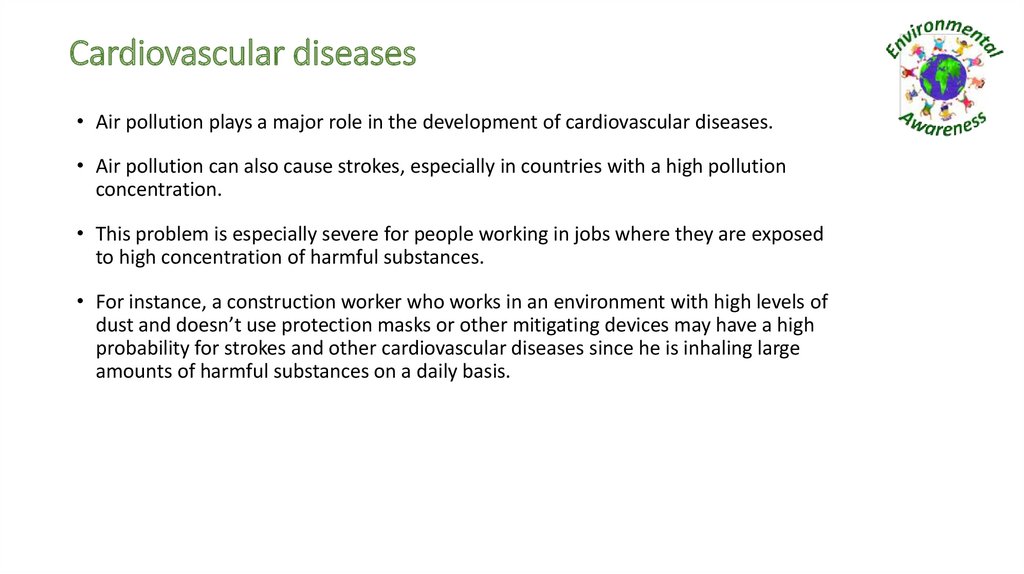



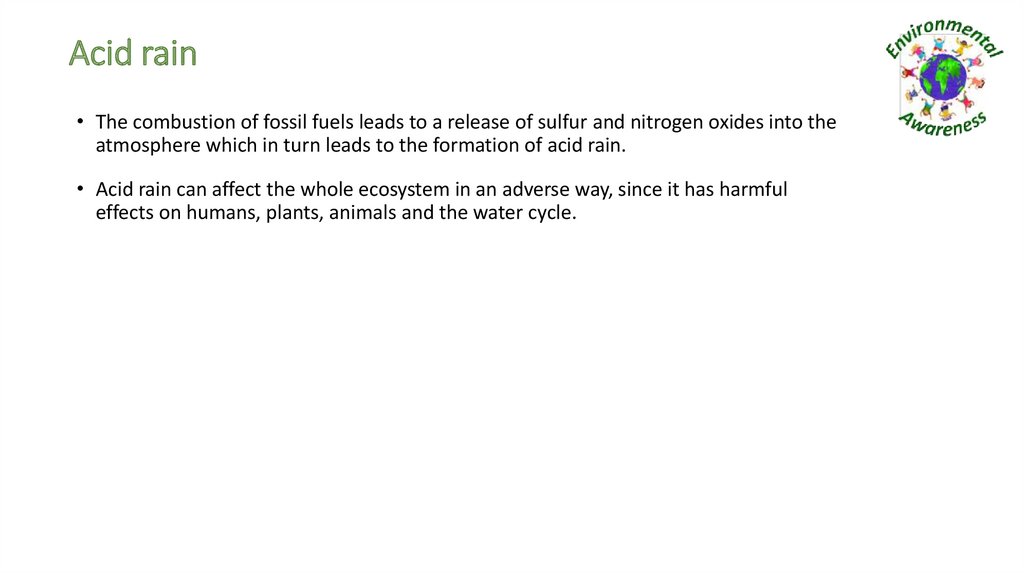
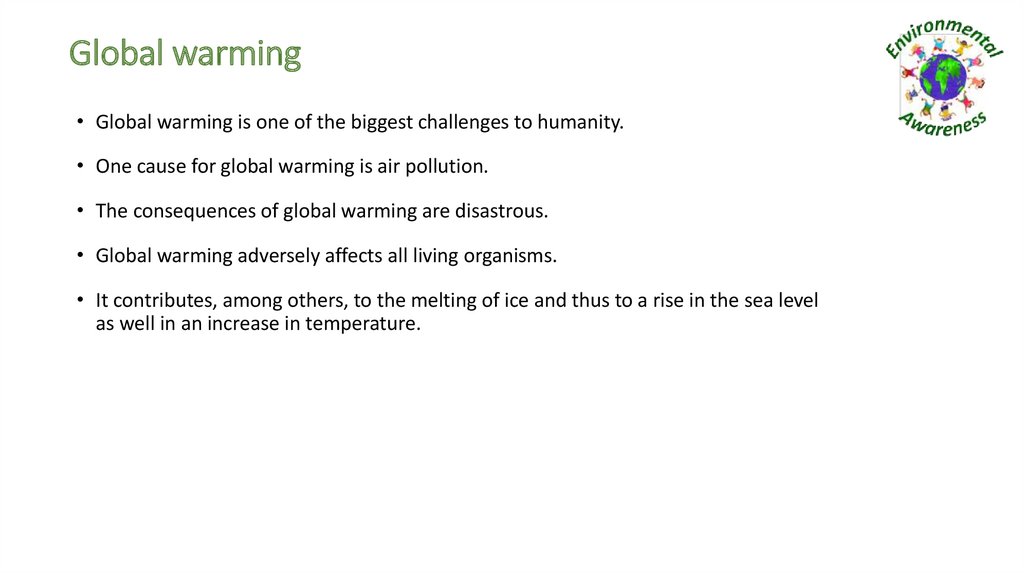
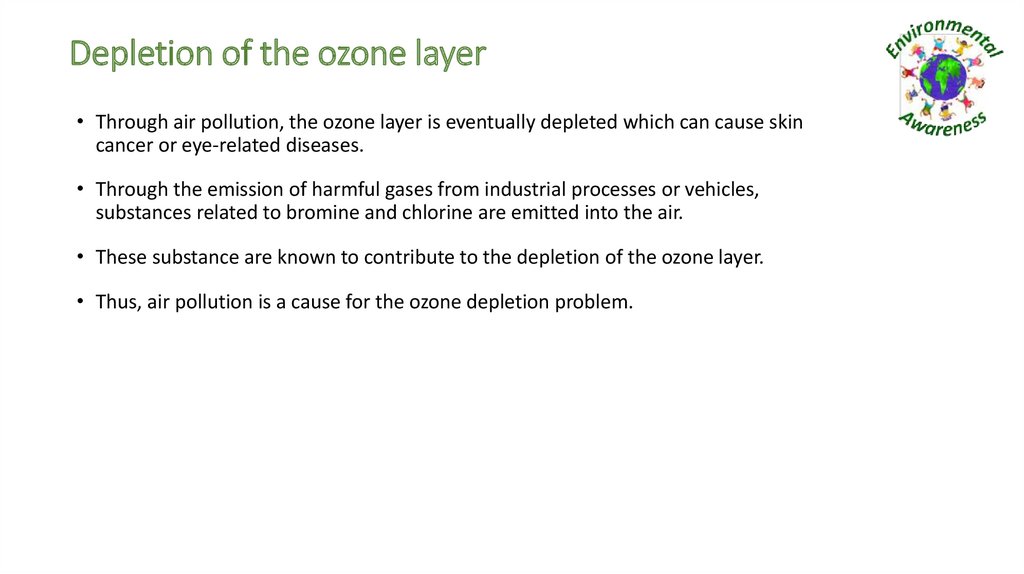









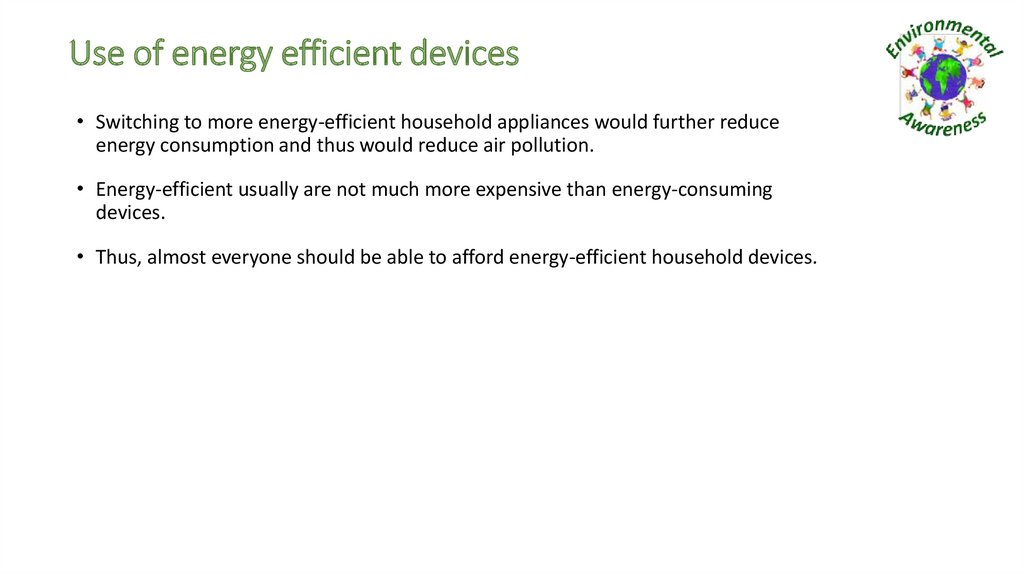



 Экология
Экология








